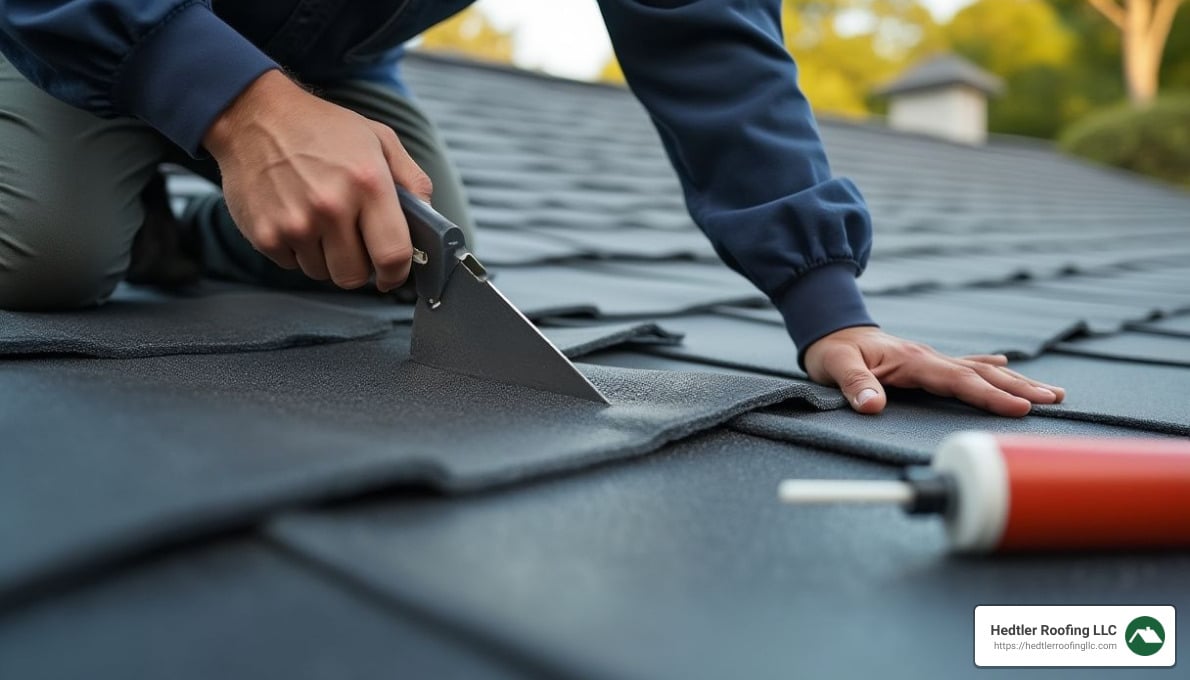How to Fix a Rubber Roof: Top 5 Expert Tips 2024
How to fix a rubber roof: It’s a task many homeowners in Massachusetts face, especially given our unpredictable weather and the wear and tear roofs endure over the years. If you’ve noticed signs of leakage in your EPDM rubber roof, you can tackle these issues yourself with a bit of know-how. Here’s a quick look at the steps involved:
- Identify the leak: Look for cracks, tears, or seam separations.
- Gather tools: You’ll need an EPDM patch, contact cement, and a utility knife.
- Clean the damaged area: Use a membrane cleaner to prepare the surface.
- Apply the patch: Secure it with contact cement and ensure edges are sealed.
Do it yourself to save on costs while extending your rubber roof’s life.
I’m Jason Hedtler, the owner of Roof Experts in Bellingham, MA. With years of experience, I specialize in guiding Massachusetts homeowners on how to fix a rubber roof efficiently. From finding leaks to applying professional-grade patches, my expertise ensures your roof stays in top shape through every New England storm.

Key how to fix a rubber roof vocabulary:
– cost of a rubber roof
– epdm membrane roof
– how long does a rubber roof last
Identifying the Problem
Before you can fix your rubber roof, you need to identify the problem. This might seem straightforward, but leaks can be tricky to pinpoint. Let’s break down the steps to help you figure out what’s going wrong.
Leak Detection
Leaks are the most common issue with rubber roofs. They often show up as water stains on your ceiling or damp spots in your attic. Water can travel far from the actual leak, so you might need to investigate a bit.
Visual Inspection: Start by examining your roof. Look for obvious signs like cracks, tears, or punctures in the rubber membrane. Standing water can also indicate a problem. Don’t forget to check seams, as they are prone to leaks.
Interior Clues: Inside your home, look for water stains, mold, or mildew. These can give you clues about the leak’s location. Damage might not be directly under the leak, but it’s a good starting point.
Seam Issues
Seams are where two pieces of rubber roofing meet. Over time, these can separate, especially if the roof wasn’t installed properly. Seam separation is a common cause of leaks.
Check Seams: Look closely at all seams for any gaps or separations. Even small openings can let water in during heavy rains.
Substrate Damage
The substrate is the layer beneath your rubber roof. If it’s damaged, it can lead to bigger problems.
Substrate Inspection: Look for signs of sagging or soft spots on your roof. These could indicate water damage below the rubber membrane. A damaged substrate needs immediate attention to prevent further issues.
Inspection
A thorough inspection is key to identifying roof problems. Use the following tips to make sure you don’t miss anything:
- Walk the Roof: Carefully walk your roof to feel for soft spots or depressions. Use binoculars to examine hard-to-reach areas.
- Check Inside: Inspect your attic or the rooms directly below the roof for water damage.
- Professional Help: If you’re unsure or can’t find the problem, consider hiring a professional. They have the tools and experience to spot issues you might miss.
By carefully inspecting your rubber roof and identifying problems early, you can address issues before they lead to costly repairs. Next, we’ll look at the tools and materials you’ll need for the repair process.
How to Fix a Rubber Roof
Tools and Materials Needed
Before you start fixing your rubber roof, gather all the necessary tools and materials. Having everything ready will make the process smoother and more efficient.
- Utility Knife: Essential for cutting the rubber roofing material cleanly.
- Putty Knife: Useful for applying patching material evenly.
- Rubber Patch: EPDM rubber patches are ideal for covering damaged areas.
- Contact Cement: This adhesive helps secure the rubber patch to the roof.
- Lap Sealant: Ensures a watertight seal around the patch edges.
- Membrane Cleaner: Prepares surfaces for better adhesion.
- Washers and Screws: Used to secure new substrate material.
- High-Density Fiberboard: Replaces damaged substrate beneath the rubber membrane.
Step-by-Step Repair Guide
Now, let’s dive into the repair process. Follow these steps to fix your rubber roof effectively.
1. Cutting the Rubber Roof
Begin by using a utility knife to cut around the damaged area. Make sure to create a square or rectangular opening for easy patching. This initial step exposes the substrate, allowing you to assess any underlying damage.
2. Removing the Old Substrate
If the substrate is wet or damaged, it’s crucial to replace it. Unscrew the metal washers holding it in place and carefully remove the old fiberboard. This step ensures a solid foundation for your repair.
3. Securing New Substrate
Cut a new piece of high-density fiberboard to fit the opening. Secure it with screws and washers, ensuring it lies flat and stable. A sturdy substrate supports the patch and prevents future issues.
4. Applying Contact Cement
Clean the repair area and the underside of the rubber patch with a membrane cleaner. Apply contact cement to half of the repair area and half of the patch. Let it dry for about 10 minutes. This adhesive step is crucial for a strong bond.
5. Applying the Rubber Patch
Align the rubber patch with the repair area and press it down firmly. Avoid stretching the material, as this can lead to leaks later. Once the first half is secure, fold back the unglued portion and apply contact cement to the remaining areas. Press the second half into place.
6. Sealing the Edges
To ensure a watertight seal, apply a bead of lap sealant around the entire patch perimeter. This step prevents water from seeping under the patch and causing further damage.

By following these steps, you can effectively repair your rubber roof and extend its lifespan. Proper preparation and careful execution are key to a successful repair. Next, we’ll explore common issues you might encounter and how to address them.
Common Issues and Solutions
Fixing Rubber Roof Seams
Seam leaks are a common issue with rubber roofs, especially as they age. Over time, the adhesive that holds the seams together can deteriorate, leading to leaks. Fixing these seams is crucial to maintaining the integrity of your roof.
EPDM Seam Repair involves cleaning the affected area thoroughly with a membrane cleaner. This ensures that the adhesive will bond properly. Once clean, apply a fresh layer of contact cement to both sides of the seam. Allow it to become tacky, then press the seams together firmly.
To provide additional protection, apply a bead of lap sealant over the seam. This will help prevent future leaks and extend the life of the repair. Regular inspection and maintenance of seams can prevent small issues from becoming major problems.
Recoating a Rubber Roof
Recoating is an effective way to restore and extend the life of your rubber roof. Over time, exposure to the elements can cause the surface of the roof to wear down. Applying a liquid sealant can refresh the roof and provide a fresh protective layer.
Before recoating, ensure the roof surface is clean and dry. Remove any debris, dirt, or old sealant residues. Once prepared, apply the liquid sealant evenly across the roof surface. This process can help fill in minor cracks and provide a uniform barrier against water.
Recoating not only extends the roof’s life but also improves its UV resistance, reducing the risk of damage from prolonged sun exposure. It’s a cost-effective way to maintain your roof without the need for extensive repairs.
By addressing seam leaks and considering recoating, you can effectively manage common issues with your rubber roof. These solutions can help ensure your roof remains in good condition for years to come.

Frequently Asked Questions about How to Fix a Rubber Roof
Can you repair a rubber roof yourself?
Yes, you can repair a rubber roof yourself if you’re comfortable with DIY projects. DIY repair is often the go-to choice for homeowners looking to save on costs. Repair kits are readily available and typically include essential items like rubber patches, contact cement, and lap sealant.
The cost of a DIY repair can be quite affordable. Basic kits might range from $30 to $50, depending on the size of the area you need to fix. However, it’s crucial to follow instructions carefully to ensure a successful repair. If you’re unsure, consider consulting with a professional to avoid potential mistakes that could lead to more significant issues.
How to fix rubber roof seams?
Fixing rubber roof seams is a straightforward process. Seam leaks often occur due to adhesive deterioration over time. To repair seams, start by thoroughly cleaning the area with a membrane cleaner. This step is essential for ensuring the new adhesive bonds correctly.
After cleaning, apply a fresh layer of adhesive to both sides of the seam. Allow this to become tacky before pressing the seams together. For added protection, apply a bead of lap sealant over the seam. This not only prevents future leaks but also reinforces the repair, extending the seam’s life. Regular maintenance can keep your seams in good shape and prevent costly damage.
Can you replace part of a rubber roof?
Yes, you can replace part of a rubber roof if the damage is localized. Partial replacement is a practical solution for areas that have sustained damage due to punctures or tears. Start by cutting out the damaged section with a utility knife, ensuring you don’t extend the cut beyond the affected area.
Next, prepare the area by cleaning it thoroughly and applying a layer of contact cement to the edges. Install a new piece of EPDM rubber and secure it with screws and metal washers, if necessary. Finish by sealing the edges with an adhesive or lap sealant to ensure a watertight barrier.
Using these methods, you can effectively manage repairs without the need for a full roof replacement. However, if you’re unsure or uncomfortable with the process, it’s always wise to seek professional help to ensure the repair is done correctly.
Conclusion
Repairing a rubber roof can be a manageable DIY task for Massachusetts homeowners, but sometimes it’s best to call in the experts. Roof Experts is your trusted partner for professional roof repairs and installations in the Franklin and Bellingham areas. With over 20 years of experience, we focus on providing high-quality service and ensuring your home is well-protected.
Our team understands the unique challenges of maintaining roofs in the Massachusetts climate. We use top-notch materials and techniques to ensure long-lasting repairs, whether you’re dealing with seam leaks or need a partial roof replacement.
Choosing professional repair services like those offered by Roof Experts means you get peace of mind. Our skilled contractors handle everything from inspections to repairs, ensuring each job is done safely and efficiently. We take pride in our detailed approach, ensuring your rubber roof stands the test of time.
For those considering a roof installation or a comprehensive repair, explore our roof installations services. Trust us to deliver quality and value for your home, keeping your roof in top condition for years to come.


